If you have ever been intrigued by the idea of growing mushrooms in your garden, this list of the best mushrooms to grow at home will help get you started. Even if you are a beginner mushroom gardener, there are a few delicious culinary mushrooms that you can easily grow. You don’t even really need a lot of space, because they can be grown indoors and in jars, as well as out in the garden.
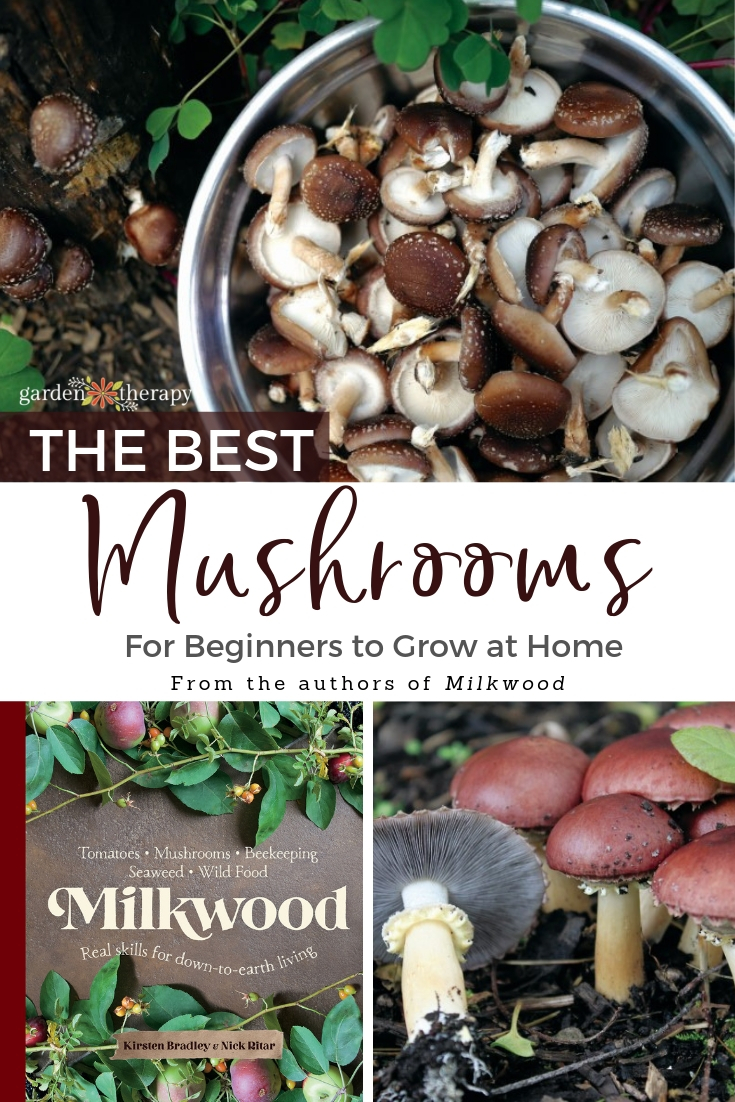
When it comes to growing vegetables, many don’t consider adding mushrooms to their list. Okay, technically they’re fungi and not a vegetable but we sure do treat them like one! They’re so tasty in stir-fries, pasta, and even fresh from the garden.
I’ve been interested in growing mushrooms at home for many years, and have grown them successfully outdoors in both bags and on logs. I’ve tried shiitake and oyster mushrooms and after reading about the other easy-to-grow types of mushrooms, I want to grow them all!
Permaculture farmers Kristen Bradley and Nick Ritar have a whole chapter of their book, Milkwood: Real Skills for Down-To-Earth Living (Murdoch Books, 2019) on growing mushrooms. It’s filled with the biology and history of mushrooms and projects to cultivate mushrooms at home like mushroom bags, jars, and holey buckets. They were kind enough to share their go-to mushrooms to grow at home at the end of this post, so be sure to read on!
Learn the best methods for growing mushrooms at home below, applying these practices inside or outside.
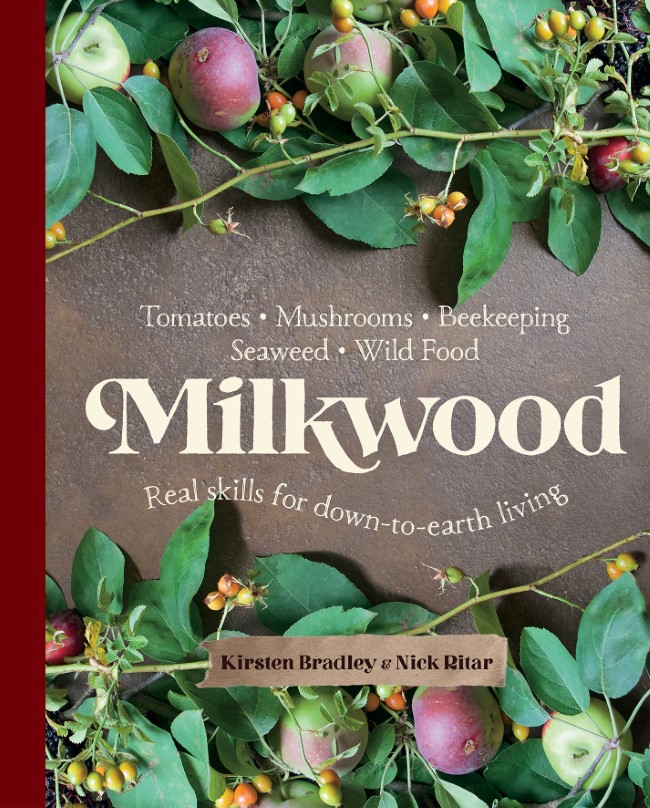
How to Grow Mushrooms Inside
Did you know it’s actually easier to grow mushrooms inside?
Because you can control the conditions, they grow much quicker indoors than they would outside. When it comes to growing mushrooms, you can buy growing kits to makes things easier or start from scratch on your own. Just make sure to purchase from reputable dealers only.
Spores Vs Spawn
You can buy either spore or spawn. Think of mushroom spores like seeds and spawn as seedlings. Spawn will be much easier to grow for beginners.
Location
Mushrooms enjoy a cool, dark, and damp location best. A basement or inside a cabinet or closet are all good locations.
You can use a container to grow them, such as empty salad containers you get at the grocery store. Just make sure the container is at least 6 inches deep to allow the mycelium (a mushroom root system) to grow.
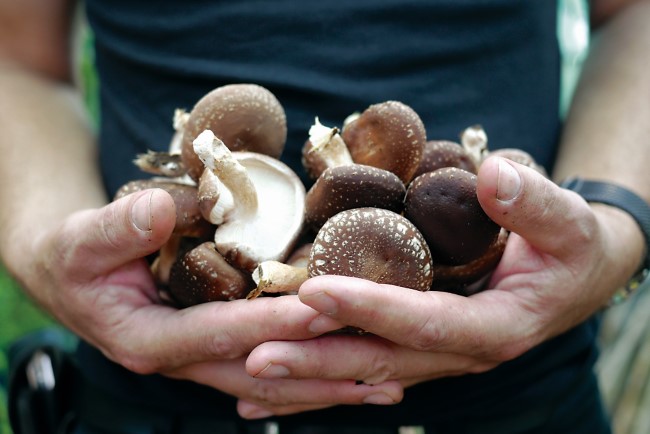
Starting Mushrooms
Different mushrooms will like different mediums. Some like to grow in coffee grounds while others prefer sawdust. Refer to the fruiting substrates in the section below on different types of mushrooms to know what to use for each.
To start your mushroom, place the spawn on its preferred growing medium. You will want to start your mushrooms at 70°F. You will want to use a thermometer to ensure you have the right temperature for your mushrooms.
If necessary, you can place their container on a heating pad to help warm them up. For the first little while, mushrooms need to remain undisturbed. Limit their exposure to heat, light, and drafts.
Once they have rooted, you can lower the temperature. This will take a few weeks. Like growing mediums, each mushroom has a preferred temperature that you can also find listed.
When you lower the temperature, you will want to cover the spawn with an inch of potting soil. Cover the soil with a damp cloth and spritz the cloth to keep it wet.
Harvesting Mushrooms
Your mushrooms will be ready to harvest when the cap has fully opened and separated from the stem. This takes 3-4 weeks on average.
Avoid pulling your mushrooms as this may damage the surrounding fungi.

FAQ About Growing Mushrooms
Is it Difficult to Grow Mushrooms?
Not at all! In fact, it’s easier to do at home inside than outside. You can harvest mushrooms in about 3-4 weeks inside after you cover the spawn with soil. Outside, this process can take anywhere from 6 months to 3 years depending on the type of mushroom!
You can learn more about growing mushrooms on logs outside on this post.
Do Mushrooms Need Sunlight?
Since mushrooms don’t contain chlorophyll, they don’t require any sunlight to grow.
Will Mushrooms Grow Back After You Pick Them?
Once you harvest a mushroom, its stem will rot away. New mushrooms may emerge and grow from other spawns or spores. To ensure you have a continuous crop, you may need to add more spawn.
Should You Pull or Cut Mushrooms?
Avoid pulling mushrooms to harvest. This can damage surrounding fungi and the mycelium below. Instead, cut the mushroom with a sharp knife right on the stalk.
The Best Types of Mushrooms to Grow at Home
by Kristen Bradley & Nick Ritar
Published with permission from Murdoch Books Australia and Quarto Homes; photographs courtesy of Kristen Bradley, Kate Berry, and Ann F Berger (CC).
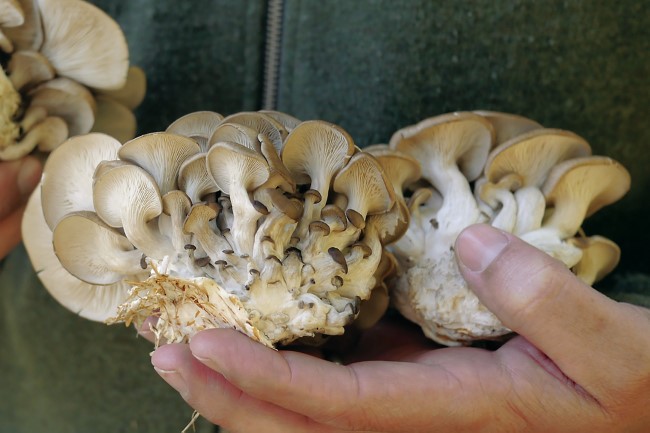
Pleurotus ostreatus (Pearl Oyster)
The species we recommend starting with for bucket or jar cultivation is the pearl oyster. There are lots of Pleurotus (oyster) species, including Pleurotus djamor (pink oyster), Pleurotus eryngii (king oyster), and Pleurotus citrinopileatus (golden oyster).
However, some of these other varieties are slightly more fiddly than Pleurotus ostreatus, so pearl oyster is a good starting point.
Preferred Fruiting Substrates
Oyster mushrooms prefer pasteurised straw or sawdust, but will fruit well on most farm waste products containing cellulose and lignin. They also like hardwood logs or stumps for outdoor cultivation.
Waste coffee grounds are becoming popular among urban growers of oyster mushrooms, but note that they must be used while very fresh as they have a relatively high nutrient content and can be prone to contamination.
Climate
Pleurotus ostreatus are awesomely adaptable and will tolerate a range of growing conditions. They should fruit anywhere from 7–25°C (45–77°F).
Time from Inoculation to Fruiting
These mushrooms grow quickly. From 2 to 3 weeks for indoor cultivation, depending on ambient temperature and the inoculation rates of substrate.
Pleurotus rryingii (King Oyster)
Considered by many to be the best tasting oyster mushroom, king oysters are a meaty, full feast that can be sliced and barbecued. They crisp up when stir-fried, yet stay wonderfully chewy and nutty.
They can be grown in a similar way to pearl oysters, but their superior flavour makes them worth mentioning. Once you’ve mastered pearl oysters, give them a go.
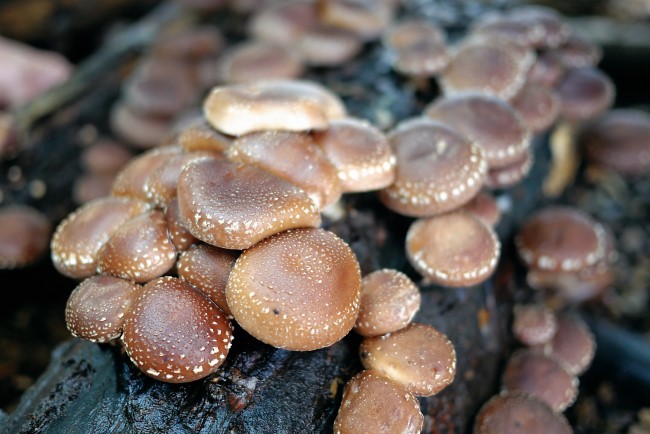
Lentinula edodes (Shiitake)
Shiitake is a great species to use when you are starting outdoor cultivation. They will grow on logs in your garden. Although they’re a lot slower to fruit than oyster mushrooms, if you inoculate a batch of logs every year (or even better, every season), you can soon have a regular supply of shiitakes.
Preferred fruiting substrates:
Hardwood logs of almost every type, though yields will vary according to the log species. Eucalypts work well if you can’t find oak, beech, or alder. They can also be grown on sawdust.
Climate
There are different strains of shiitake, but the main strain that we use fruits between 14 and 20°C (57 and 68°F), which is a wide enough bracket for most temperate climates. There are both colder and warmer strains that fruit below, and above, that temperature envelope.
Time from Inoculation to Fruiting
Long. On logs: from 6 to 12 months (or longer), depending on climate and inoculation rates of the log. On sawdust blocks: 7 to 10 weeks. Worth the wait!
Agrocybe aegerita (Velvet Pioppini)
Native to poplar wood, this is a delicious mushroom with a nutty bite. It’s great for stir-fries and other cooking methods.
Preferred Fruiting Substrates
Hardwood sawdust is best. This one is great for jar cultivation. It also does well on logs and stumps.
Climate
Keep it cool –pioppinos like to stay around 13–18°C (55–64°F), and tend to fruit in the spring, after the colder months.
Time from Inoculation to Fruiting
Long – 8 to 12 months for outdoor log cultivation or about 6 weeks for indoor cultivation.
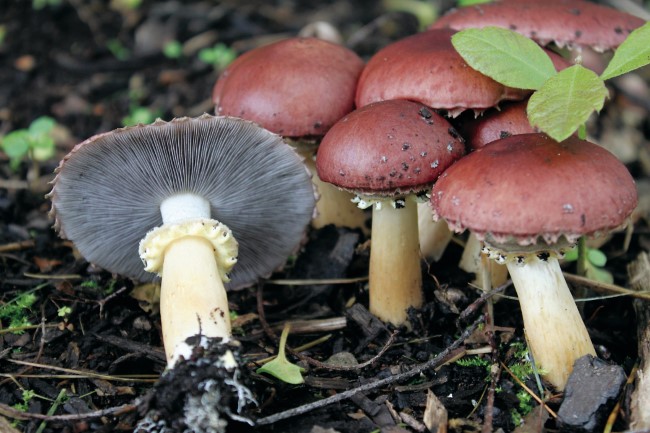
Stropharia rugosoannulata (King Stropharia or Garden Giant)
This is our favourite mushroom to grow in wood chip gardens. It’s easy to grow and delicious to eat.
Preferred Fruiting Substrates
Hardwood wood chips are preferred, but, like oyster mushrooms, king stropharia will grow in straw and many other farm waste products.
Climate
King stropharia grow in a very broad range of temperatures, from about 5–35°C (41–95°F), so they’re great for both temperate and subtropical climates. They do need good moisture, however, so make sure this is supplied consistently.
Time from Inoculation to Fruiting
Long. About 4 to 6 months, depending on inoculation rates and which substrate you use.




I love mushrooms! Thank you for convincing me that I need to grow mushrooms! 💕